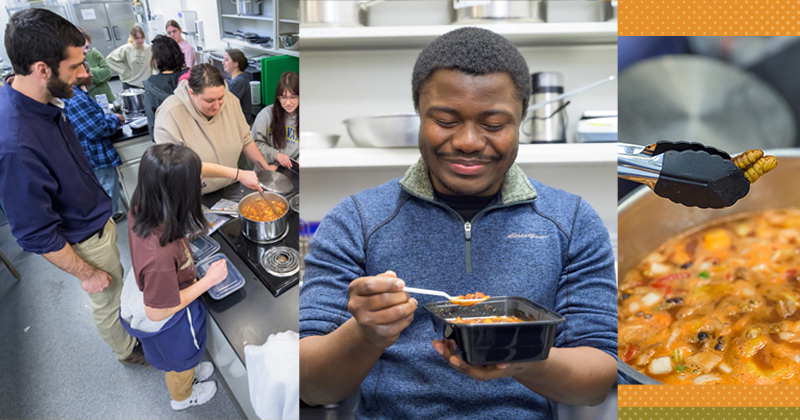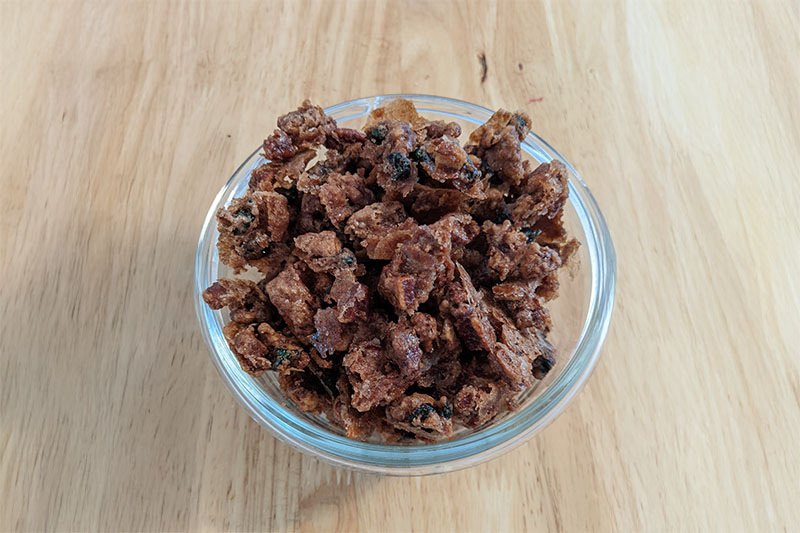


Bug bites
Photos by Evan Krape | Photo illustration by Jeffrey C. Chase May 07, 2025
A new course exposes students to the sustainable world of insect cuisine
It’s a nutritious food source packed with proteins, vitamins and healthy fats. It’s also a popular one, consumed annually by more than 2 billion people around the world.
Entomophagy, the practice of eating insects, has been a part of human life and culture for thousands of years. Today in Thailand, crickets, silkworm pupae and giant water bugs are menu staples — often deep fried, coated in sauces, added to soups and omelettes, or eaten solo as a crispy snack. In Nigeria, palm weevil larvae are roasted, boiled or fried. In Mexico, grasshoppers and ants are common delicacies.
In the U.S., insects are an uncommon addition to the dinner plate. The U.S. Food and Drug Administration has stated that insects can be considered food if they follow the regulations of other foods, but the agency lacks specific regulations about insects as food (it does, however, allow a certain threshold of insects as an “unavoidable defect” before a food is considered contaminated).

A small but growing number of restaurants in the U.S. are cooking up insect-based dishes. Some insect farmers even sell roasted crickets and cricket powders at farmers markets. But the idea of incorporating bugs into the mainstream diet is still on the fringe. The largest barrier? The “ick” factor.
Michael Crossley is trying to break that barrier down. In the University of Delaware College of Agriculture and Natural Resources (CANR), the assistant professor and agricultural entomologist has launched a new course, Insects as Food (ENWC 267).
Over the semester, more than two dozen students learned how insects are harvested, farmed and regulated. They each took home their own small insect farms, raising black soldier fly larvae on kitchen waste and superworms on grains and plastic, tracking their growth and survival over four weeks. And, of course, they got hands-on experience cooking several insect-based dishes.

“My biggest goal is to give students experiences to help them appreciate the possible roles insects can play in our food systems,” Crossley said.
That role extends beyond the family grocery list to include the bigger environmental picture. Insects are a sustainable food source because they require less water, land and feed than traditional livestock. Some, like black soldier fly larvae, can even break down food waste that would otherwise go to landfills, and instead upcycle that waste into animal feed and fertilizers.
Serving up!
As the brains behind the Insects as Food course, Crossley has naturally experimented with edible insects himself.
Just like his students, he, too, discovered entomophagy as a college student — at the University of Wisconsin-Madison about 15 years ago. But his foray into insect cuisine really began in 2020, when he collected edible weeds from his yard and sprinkled some roasted crickets on top. Crossley called the dish a “wild salad.” It was an instant hit with his family.

Then, during a camping trip in Michigan in 2024, Crossley asked his son to collect some mayflies, which he then fried on his camp stove and served with butter and parsley.
“They tasted like popcorn,” he said. “Everybody enjoyed it. It was gone within minutes.”
Crossley’s personal favorite insect dish? Candied Japanese beetles covered in butter and sugar.
“Any day, I’ll eat that,” he chuckled. “It’s just so good.”
So in the spring 2025 semester, Crossley brought his knowledge, ingredients and various insects and insect powders to the Worrilow Hall test kitchen, where students in the course whipped up several insect-based dishes, largely from recipes Crossley found online, along with one he created himself (black ant lemon scones).

The appetite for such a course was rather overwhelming. Students came from traditional CANR majors like insect ecology and conservation and wildlife ecology and conservation, but the novel class also attracted majors in fields like marketing, marine science and mechanical engineering.
Students started their culinary insect journey whipping a fruit vanilla smoothie that incorporated mealworm protein powder — the bug flavor was barely noticeable.
Then came cricket granola, made with a cricket flour that infused the kitchen air with a peanut butter-like aroma.
“It really came together,” said Samuel Truluck, a senior marketing major, who would “absolutely” eat it again. “I tried it before I added cranberries. At first, it didn’t have all the pieces. But once I got it all together, I thought, ‘Oh my gosh a bucket of Chobani would totally destroy this.’”

Other fan favorites included spicy waterbug pasta salad and black ant lemon scones. During one of the course’s most exciting days, students cooked Sago worm and black bean chili. It was the first recipe where the bugs — both Sago worms and silkworms — were in plain sight.
The result was … surprising.
“The Sago worm’s texture threw me off a little bit,” Kevin Winton, a senior wildlife ecology and conservation major, said of the unexpected crunch. “I thought it would have a lot more liquid, being in the soup for as long as it was. And it doesn’t really have too much flavor to it. A lot of the flavor really comes from what you make with it. So I think adding all of the vegetables and the spices really did help out.”
Prior to the class, Winton’s only foray into entomophagy was a scorpion lollipop at a museum, making the Insects as Food course an especially eye-opening experience.
“Consuming insects is not just grabbing a fly out of the air and popping it in your mouth. It’s a lot more nuanced than that,” Winton said. “Most of the communities that eat insects have been doing it for years and years and passed it onto their children and grandchildren.”
The cultural significance of insect cuisine also impressed Paige Akers, a senior insect ecology and conservation major who plans to incorporate insects into her daily diet to be more sustainable.
“I think they taste good,” Akers said. “And people do it all over the world, so why not incorporate it here?”
Feed the world, protect the planet: Are insects the answer?
By 2050, the world’s population is expected to grow to between 9 billion and 10 billion people. The Food and Agriculture Organization of the United Nations estimates that food production will need to double to feed the world.
Meanwhile, insects are the most abundant creatures on Earth, begging the $9 billion to $10 billion question: Are they the answer to feeding a growing population?
Crossley isn’t sold on that.
“Insects are not the silver bullet,” he said. “They are one part of the answer.”
Crossley doesn’t see insects as a silver bullet partly because their exoskeletons contain a lot of chitin, a molecule that the human body can only handle in limited quantities (think fiber). And producing enough insects in the U.S. to feed the world will require billions of dollars of investment, Crossley added.

Although edible insects can contain more protein than conventional meat (for example, one serving of chicken contains about 30 grams of protein while a serving of the box of silkworm pupae Crossley used to supplement the Sago worm chili has a whopping 55 grams of protein) it comes down to consumer preference.
But the demand for edible insects will likely grow. And with it, so will the need for people who know how to produce insect-based food.
“This course is not going into details of the food science of an insect,” Crossley said, “but it is an entry point.”
As he looks ahead, Crossley hopes the course could help change public perception, just as entomophagy changed his perception 15 years ago.
“Every time someone hears of the idea, I think it’s chipping away at a mountain,” he said.
Contact Us
Have a UDaily story idea?
Contact us at ocm@udel.edu
Members of the press
Contact us at mediarelations@udel.edu or visit the Media Relations website

